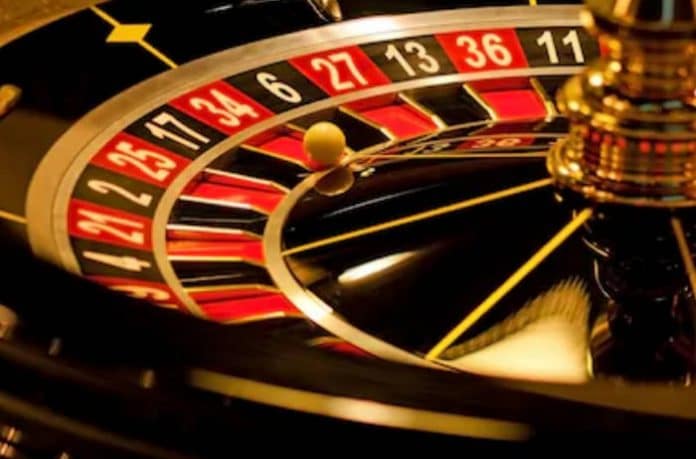Wheel bias is when specific numbers win more than they should. This is caused by roulette wheel defects. Most players know about wheel bias. But what they think they know is a bias player will analyze a lot of spins, then just bet on whatever numbers spun most. This may have worked 100 years ago, but the bias developed by modern wheels is not as prevalent.
What Causes a Biased Wheel

There are countless causes of a biased wheel, but I’ll give one example. The wheel may have the colored plastic glued to the pocket, and over time the glue may have loosened, which raises the plastic. When the ball hits such pockets, the ball doesn’t bounce as much. This is called “deadening”, and it leads to ball tending to come to rest in specific areas more often that it would if spins were completely random.
Modern Biased Roulette Wheel Analysis
Almost every casino uses automated software that analyses the winning numbers to determine if there are any obvious anomalies such as specific numbers spinning most. The better equipment will do much more than just look at “which numbers spin most”.
The following material is the bias analysis chapter of the Primordials document from my roulette system. Simply put it is the basics of advanced roulette wheel bias analysis. I give it for free because my more advanced methods are much more powerful – quicker, easier to use, and more accurate.
Introduction to biased wheel play
A biased wheel is a wheel where one or more numbers are more likely to win. It is the result of a manufacturing defect, or general wear and tear of a wheel. Even new wheels can exhibit a bias, although a bias occurs more frequently on older wheels. As a general rule, other than color or number, anything that makes one pocket different from any other usually leads to some form of bias.
Most professionals would tell you biased wheels are rare, but they do exist. More accurately, because it is impossible to manufacture a “perfect” wheel, every wheel is biased to a degree, but whether or not that bias alone is great enough to overcome the house edge is different. Usually it isn’t, but as discussed in previous chapters, beating roulette is not always just one technique – it’s usually a combination of different techniques that contribute to your “overall” edge. Even if a biased wheel gives you an additional 0.5% edge, that’s still worthwhile. Consider the house edge is also very slight, but it means most other players can lose thousands very quickly.
Finding and exploiting biased wheels is not as simple as finding which numbers spin most, then betting on them. As this chapter will explain, there’s a lot more to it. The online software available to players will do a bias analysis for you which makes things easy for you. If the bias is statistically significant, it will be incorporated into custom variants. However this section will explain how to detect and exploit a wheel bias without the use of the software.
Types of Bias
Pocket Bias: the ball will favour singular pockets
Section Bias: the ball will favour specific wheel sectors
Dynamic Bias: This is a bias that exists only for a short term (usually a few hundred spins). Detecting such a bias manually is quite tricky, although the online custom variant software checks for you. Usually you can predict the evolution of a bias and adjust bets accordingly. “Modern” wheel analysis software completely neglects this type of bias, and this is to your advantage.
The primary causes of a bias
Loose Frets: the frets are the pocket separators. If they become loose, they can absorb impact better than other pockets which creates an effect whereby the ball will come to rest in a specific pocket or wheel sector more than any other.
Deadening of pocket surface: minor scratches on the pocket surface (barely visible to the naked eye) can lead to a difference in friction or level of absorption of impact. This can make the ball come to rest in specific sectors more than others.
Difference in size of pockets: no two pockets are exactly the same size. The larger the pocket, the more likely the ball will come to rest in that pocket.
Wheel Wobble: this is where the actual rotor is on a slight angle, meaning one side of the rotor is even a fraction of a millimeter lower than the opposing side. Due to gravity, the ball will tend to favour the lower side of the wheel rotor. Wheel wobble is relatively easy to observe, even without spin collection, as explained in previous chapters.
Uneven Wheel Deceleration: An unbiased wheel will spin with smooth rotations and a constant deceleration. On some wheels, you may notice the wheel will decelerate quicker when the zero is at a particular point around the wheel base. This can be due to many reasons, but it usually because of a slightly distorted wheel shaft. Importantly, often it will only occur when a specific wheel rotor and wheel base combination is used. In particularly on a clearly tilted wheel or any similar condition where the ball has a common drop point, this effect will almost certainly lead to a sector bias because there will be a dominant wheel orientation in relation to the common ball drop point.
Common Ball Drop Points: As discussed in previous chapters, many factors such as tilt can lead to common ball drop points. Not always are they relevant to wheel bias, but in the case of uneven wheel deceleration, common drop points are required for a sector bias to develop. This is because if where the ball fell was “random” (unpredictable), then where the wheel will be doesn’t make a difference.
Low Quality or Deformed Balls: balls are never perfectly round. The less perfect they are, the more likely they are to be affected by ball track defects such as cracks and track deformation.
Identifying wheels that are most likely to be biased
You of course need to collect and analyze spins to detect/confirm wheel bias, but there are many things you can do and observe to determine if a wheel is likely to be biased. That’s exactly what this section is about: narrowing down your selection of wheels to focus on the ones most likely to exhibit a significant bias. This can greatly reduce the amount of time required to find an authentic biased wheel. As with any of the other techniques, you don’t just start playing or analyzing any wheel.
Use the below guidelines to identify wheels that are most likely to exhibit a bias:

Tilted wheels: the greater the wheel tilt, the more likely a wheel is to exhibit a bias. Wheel tilt itself is not exactly a bias, but when in combination with a genuine bias such as uneven wheel deceleration, this condition will lead to primarily a sector bias. In other words, some forms of bias are dependent on the wheel being tilted. To determine the level of tilt a wheel has, simply mark on a chart where the ball either struck a diamond or lost momentum and fell. An example of a chart is shown left. NOTE: You mark the points only with reference to the wheel base, not the actual wheel rotor.
Older style wheels: the older a wheel design, the more likely it is to be biased.
Higher frets (pocket separators): higher frets are more likely to exhibit mechanical flaws.
Wheel Wobble: move to a location where you can see a strong light reflection in the points marked in the below image. This will make it easy to see a wobble because you may notice a very slight movement when the wheel comes around. Also stand at points where the strong reflection is at different parts around the wheel because often a wobble will only be visible at particular parts around the wheel.
Uneven Wheel Deceleration: This is difficult to observe, so is often overlooked and not noticed by casino staff. You will sometimes see the wheel slightly suddenly decelerates when the zero is at a specific point around the wheel base. How you detect it depends on personal preference, although I prefer to simply observe green zero intensely for a few spins as it goes around and around.
Common Ball Drop Points: As discussed in previous chapters, many factors including but not limited to tilt can lead to common ball drop points. Not always are they relevant to wheel bias, but in the case of uneven wheel deceleration, common drop points are required for a sector bias to develop. This is because if where the ball fell was “random”, then where the wheel will be doesn’t make a difference. The method to find common drop points is the same for finding tilted wheels.
Low Quality or Deformed Balls: If a ball is deformed, you will hear it rattle at different parts of the ball track. If the ball rattles at the same parts of the track, then it is more likely a ball track deformation.
Deformed Ball Track: This leads to common drop points so you would detect it when you create your chart to determine wheel tilt. If it is the track that is deformed, no matter what ball is used, you will find the ball usually rattles at the same part of the ball track. By listening for the rattle and noting where a rattle occurs, you can detect deformed ball tracks and likely common drop points in less time. You still create ball drop charts, but listening for rattles can help narrow down your wheel selection.
Collecting Spins for Analysis
In particularly sector bias relies on the wheel rotor spinning the same direction, the following factors must be considered when collecting spins:
It MUST be the same wheel and rotor: Wheels weigh as much as a person and are difficult to move. Wheels are still of course moved and even rotated on the same table. But the most common countermeasure a casino applies to make application more difficult is changing rotors between wheel bases. It is very quick and easy for casinos to do, and many do it frequently. This is why it’s absolutely essential you keep detailed notes of the wheel’s physical properties for both the wheel base, and the removable rotor. In particularly take note of scratches, wood grain, and their positions relative to each other. Be detailed and specific so that anyone would be able to find the wheel and/or rotor. Depending on the type of bias, you can sometimes track just the wheel rotor or main part of the wheel. But often a bias will only occur when the correct rotor is used on the correct wheel base (the combination).
Approximately the Same Rotor Speed: You can’t of course know precise rotor speeds. You are permitted a certain degree or error tolerance, but of course the more consistent the rotor speeds, the easier it is to detect a bias, in particularly a sector bias. For example, if a specific sector of the wheel is “deadened” (less bounce), the wheel needs to be approximately the same speed. This is because a faster wheel will mean the ball bounces further along the wheel before coming to rest. You will find that specific dealers tend to favour around the same wheel speed range.
Approximately the same ball size and type: the ball must be at least close to the same size and elasticity (bounce) because larger and bouncier balls travel further before finally coming to rest. This is particularly important for detection and play of wheels with a sector bias. Also consider the less perfectly round a ball is, the more likely a bias is to form. You can usually hear the rattle of a deformed ball. Such balls are very bad for some ballistic methods such as roulette computers (unless it has the correct features to deal with such conditions as my computers do), but they can assist the bias player.
Various Conditions: sometimes a bias will only be apparent under certain conditions, including but not limited to dealer, weather, air pressure, time of day, the ball used and location of wheel. This is why what may appear to be a genuine bias may come and go. A casino’s technology to detect a bias typically does not track such conditions, so keeping conditions as consistent as is possible and practical when collecting spins or playing can enable you to exploit a bias a casino’s technology would not detect. Do not neglect this because you may be able to discover a bias that casino technology misses.
Wheel base orientation: often rather than moving a wheel, a casino will just rotate the base. This will affect common ball drop points and can lead to a bias in different sectors. Throughout your spin collection process, ideally the wheel base must not have been moved at all. If it is, some types of bias may not be detected. Your notes about a wheel must therefore include information to determine wheel orientation.
Always keep detailed and organized records of your spins and the conditions. You should be able to look at any set of spins and know various details such as the ball used, wheel speed range, dealers and more. If you check for a bias in each segregated group of spins, you are far more likely to detect a bias, even when a casino’s pattern analysis technology does not detect a bias.
Analyzing Single Number Bias
The easiest way to analyze any spins is with the player only online software. Just enter your spins and the software will do the analysis. The next best way is to just use the charts below (e-mail me for printable version):
Analysis chart for 1500 Spins (Single Number Bias, European Single 0)
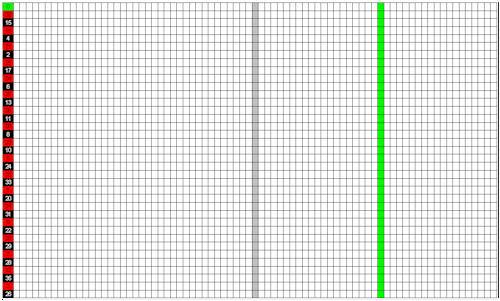
Analysis chart for 1500 Spins (Single Number Bias, American 00)
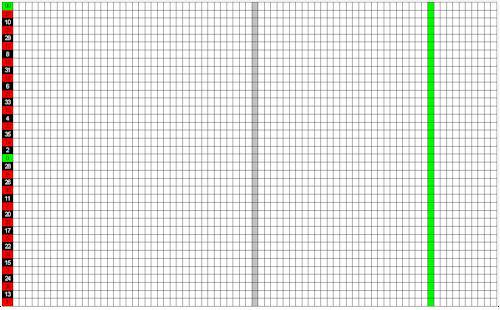
To use these charts, you need to chart 1500 spins. Starting from the left, place an X in the boxes corresponding to the winning numbers. The grey column is about where you can expect the X’s to extend to. If specific numbers or sectors are close to or past the green column, the wheel may be biased.
Although you can use these charts, the online wheel analysis software is more accurate, and you aren’t limited to using only 1500 spins.
Analyzing Sector Bias
To detect singular pocket bias you may need thousands of spins, but you can detect a sector bias with far fewer spins. For a sector bias, you need at least 400 spins. Use the charts below. What you are looking for is 19 pockets at or past the green line after 400 spins. The 19 pockets must of course be neighbors.
400 Spins, Wheel Half Bias (European Single 0)
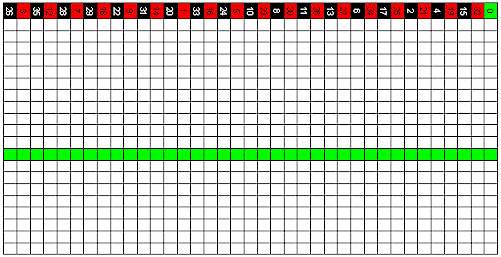
400 Spins Wheel Half Bias (American 00)
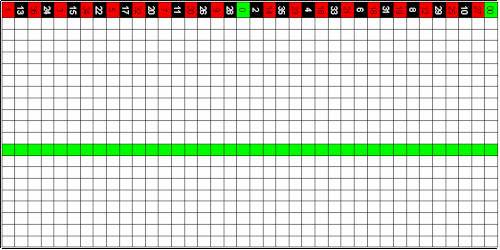
Remember to dramatically increase your chances of detecting a biased wheel, test spins that were generated under conditions that are as consistent as possible. This is often essential for the modern wheel bias player because they need to detect a bias that the average casino wheel analysis software cannot detect.
When you find a biased wheel
When a wheel appears to be biased, do the test once more. This is required to confirm the bias and unless you do this, there’s still a reasonable chance it’s not an authentic bias. If the test is passed, there’s very little chance that it is merely coincidence. Remember to keep the conditions as consistent as possible. If the much the same charts develop, then you’ve almost definitely found a biased wheel.
To play the wheel, assuming the conditions are as closely matched as possible, place your bets. While you play, observe the wheel closely to note if conditions change. For example, pay close attention to factors like tilt, ball drop off points, change of ball type etc. If conditions change, the bias may no longer exist, at least until the conditions become what they were previously.
Why Casino Wheel Bias Technology is Inadequate
Although some casinos don’t even have bias analysis technology, most do. The current leading supplier of such technology is TCS John Huxley. Some technology will take into account factors such as wheel speed in combination with winning numbers, while some only consider the winning number. Very rarely does a casino’s software take into account the various conditions, including but not limited to room temperature, ball in play, dealer, combinations of wheel bases and rotors etc. Especially casinos that only analyze winning numbers may be convinced their wheels aren’t biased, and this is to the benefit of the serious player. But even if a casino knows a wheel exhibits a bias, they often will not do anything about it until they notice someone is exploiting it.
The above material is just the basics of my advanced wheel bias analysis methods. It is an extract from the Primordials document given to my players. The Primordials document is only the introduction document for new players. For new players it may seem complicated with a lot to learn. While my advanced methods are far more complicated, the automated analysis software makes application of the techniques incredibly simple.
To get the best free roulette systems that really work, see the top 5 proven roulette systems and the video series below. It's the best 100% free information for winning roulette you'll find. It's written by professionals who are really earning a living from roulette. |

